Identification of Bioactive Compounds in Methanolic Extracts of Some Selected Plants by Infrared Spectroscopy
| Received 25 Jul, 2022 |
Accepted 31 Mar, 2023 |
Published 30 Jun, 2023 |
Background and Objective: When two or more herbs are used in formulations, they are known as polyherbal formulations. This study evaluated the bioactive ingredients in some selected herbs commonly used in polyherbal mixture formulations by infrared spectroscopy. Materials and Methods: Fresh samples of Vernonia amygdalina leaves, Allium sativum, Garcinia kola, Curcuma longa and Zingiber officinale were purchased from Wukari New Market, Taraba State, Nigeria. The methanolic extract of the samples was obtained and Fourier Transform Infrared Spectrophotometer (FTIR) analysis was conducted on the extracts. Results: The FTIR spectra of the extracts showed bands and wave numbers of between 3280 cm‾1 and 991 cm‾1 as the prominent peaks. The peaks at these frequencies were strong, broad and medium, which confirmed the presence of compounds with the functional groups of alkanes, alkenes, amines, carboxylic acids and alcohols in the extracts. Conclusion: All the samples showed a consistent presence of similar classes of organic compounds. The results of the study confirmed that the selected herbs are vital wellsprings of phytochemicals that offer conventional therapeutic treatment for different infirmities.
INTRODUCTION
For thousands of years, Chinese physicians have utilised herb-herb combinations, often known as polyherbal treatment, although there is little scientific proof of their medicinal advantages1. In comparison to a single medicine, a pharmacological combination frequently shows promise in the treatment of disorders. In Western medicine, the idea of pharmacological combinations is well-established and it has seen a lot of success over the years.
Drug combination therapies for infectious illnesses and cancer have given patients fresh hope in recent years2. It has been demonstrated that both naturally occurring herbs and herbal components combined into specific formulae may interact. These include mutually beneficial interactions, mutual support, mutual restriction and antagonistic interactions3. The majority of polyherbal substances are utilised in the Ayurvedic medical system to treat a variety of illnesses. Plumbago zeylanica, Picrorrhiza kurroa, Piper nigrum, Zingiber officinale, Sodii carbonas impura, Phyllanthus emblica, Terminalia chebula, Calcii oxidum Potassii and carbonas impura make up Hepax-A polyherbal4. Ayurvedic doctors frequently recommend Indukantha Ghritha (IG), a polyherbal remedy made up of 17 plant components, for a variety of diseases5.
As a result of the incredible clinical success of its formulations, the Unani system of medicine is also gaining popularity on a global scale. Although unani remedies have been used for a long time, there is no evidence to support either their usefulness or safety. The absence of review has therefore hindered the creation of rules and laws6. The Majoon Suranjan (MS) is a polyherbal formulation used in the Unani system of medicine for the treatment of rheumatoid arthritis that contains Lawsonia inermis, Foeniculum vulgare, Capparis spinosa, Terminalia chebula, Ipomoea turpethum, Zingiber officinalis, Convulvulus scammony, Colchicum luteum, Cassia angustifolia, Piper nigrum, Coriandrum sativum, Rosa damascus, Origanum vulgare, Pyrethrum indicum, Plumbago zelanicum, Verbascum thapus and Ricinus communis. A successful attempt has been made to create a polyherbal formulation combining the leaf extracts of Glycosmis pentaphylla, Tridax procumbens and Mangifera indica, which was then tested for antiarthritic activity7.
Studies revealed that some plants (Vitis vinifera, Phyllanthus emblica L., Punica granatum, Cinnamomum cassia, Ginkgo biloba L. and Camellia sinensis Linn.) had high concentrations of phenolics and flavonoids and that the polyherbal combination of these plants and green tea had the highest level of antioxidant activity than all the individual extract8. Because of their synergism and less adverse effects, herbal mixtures (polyherbal) are often preferred over single herbs in most traditional methods for managing diabetes9. The polyherbal formulation used to prepare the diabetic wound area was shown to be equally as safe and effective in treating diabetic foot ulcers as the common silver sulphadiazine cream10.
The anti-inflammatory activity of the polyherbal formulation Entox® consist of Allium cepa, Allium sativum, Aloe vera, Cajanus cajan, Coccinia indica, Caesalpinia bonducella, Ficus bengalenesis, Gymnema sylvestre, Momordica charantia, Ocimum sanctum, Pterocarpus marsupium, Swertia chirayita, Syzigium cumini, Tinospora cordifolia and Trigonella foenum-graecum was investigated in rats for acute and sub-acute models of inflammation using carrageenan-induced rat paw edema and cotton pellet granuloma methods respectively at a dose of 300 mg kg–1 and 600 mg kg–1 administered orally. In all animal models, the formulation significantly reduced inflammation and its anti-inflammatory effects were equivalent to those of the widely used medication indomethacin11. The BHUx, a proprietary polyherbal formulation made from the aqueous fraction of five ayurvedic medicinal herbs, significantly reduces inflammation by inhibiting cyclooxygenase-2 and lipoxygenase-1512. The polyherbal formulation “Bhāra gyādi” containing ingredients such as Clerodendrum serratum, Hedychium spicatum and Inula racemosa, was known to possess antioxidant activity13.
In an attempt to increase the horizon of polyherbal formulations, Vernonia amygdalina leaves, Allium sativum, Garcinia kola, Curcuma longa and Zingiber officinale were investigated for their bioactive components by FTIR spectroscopy in this study. This investigation was aimed at facilitating the formulation of a polyherbal mixture from these plants for efficacy and mechanistic analysis through animal studies.
MATERIALS AND METHODS
Study area: The study was carried out in the Department of Biochemistry, Federal University Wukari, Taraba State Nigeria from April, 2021 to April, 2022.
Collection of plant material: Fresh samples of the Vernonia amygdalina leaves, Allium sativum, Garcinia kola, Curcuma longa and Zingiber officinale were purchased from the Wukari New market, Taraba State, Nigeria.
Preparation and extraction of plant material: The samples were air-dried for five days. The dried samples were coarsely pounded using a pestle and mortar and stored in tightly covered glass jars for methanolic extraction. The powdered material of the plant parts was soaked in 500 mL of methanol for 24 hrs at room temperature. The extracts were filtered through Whatman No. 1 filter paper. After the filtration, the filtrates were concentrated to dryness and kept in a refrigerator for the spectroscopy analysis.
Fourier Transform Infrared Spectrophotometer (FTIR): In order to prepare a translucent sample disc, exactly 10 mg of the extract was encapsulated in 100 mg of KBr pellet. The encapsulated sample disc was loaded in the FTIR spectroscope of a scan range from 400 to 4000 cm–1 with a resolution of 4 cm–1 according to Pakkirisamy et al.14.
RESULTS
In the present study, the biochemical contents of five different plants were investigated using FTIR spectroscopy by monitoring different functional groups. The spectra were shown in the figures while the interpretations were given in the tables.
FTIR spectroscopy of Garcinia kola: The FTIR spectrum of Garcinia kola in Fig. 1 has bands and wave numbers of 3280 cm–1 to 2926 cm–1 as the prominent peaks. The peaks at the frequencies of 3280 cm–1 to 995 cm–1 were strong, broad and medium. The present FTIR results confirmed the presence of alkanes, alkenes, amines, carboxylic acids and alcohols in the extract of Garcinia kola in Table 1.
FTIR spectrum of Vernonia amygdalina: In the FTIR spectrum showed in Fig. 2, the leaf extract of V. amygdalina has bands and wave numbers of 3280 cm–1 to 2922 cm–1 as the prominent peaks. The peaks at the frequencies of 3280 cm–1 to 1017 cm–1 were strong, broad and medium. The results confirmed the presence of alkanes, alkenes, amines, carboxylic acids and alcohols in the extracts of V. amygdalina as shown in Table 2.
FTIR spectrum of Allium sativum: Considering the FTIR spectrum showed in Fig. 3, the extract of Allium sativum has bands and wave numbers of 3276 cm–1 to 2855 cm–1 as the prominent peaks. The peaks at the frequencies of 3276 cm–1 to 1006 cm–1 were strong, broad and medium. Table 3 confirmed the presence of alkanes, alkenes, amines, carboxylic acids and alcohols in the extract of Allium sativum.
FTIR spectrum of Zingiber offinale: Zingiber offinale extract has bands and wave numbers of between 3280 cm–1 to 2922 cm–1 as the prominent peaks while those peaks between the frequencies of 3280 cm–1 to 991 cm–1 were strong, broad and medium as demonstrated in Fig. 4. The FTIR results confirmed the presence of alkanes, alkenes, amines, carboxylic acids and alcohols in the extracts of Zingiber offinale in Table 4.
FTIR spectrum of Curcuma longa: Figure 5 showed that Curcuma longa has bands and wave numbers of between 3628 cm–1 to 2922 cm–1 as the prominent peaks. The peaks between the frequencies of 3628 cm–1 to 998 cm–1 were strong, broad and medium. The presence of alkanes, alkenes, amines, carboxylic acids and alcohols in the extract of Curcuma longa was obvious in Table 5.
FTIR spectrum of the plant mixture: The FTIR spectrum in Fig. 6 showed that the extract of the combined mixture has bands and wave numbers of between 3291 cm–1 to 2922 cm–1 as the prominent peaks. The peaks between the frequencies of 3291 cm–1 to 1002 cm–1 were strong, broad and medium. The present FTIR results confirmed the presence of alkanes, alkenes, amines, carboxylic acids and alcohols in the extract of the combined mixture in Table 6.
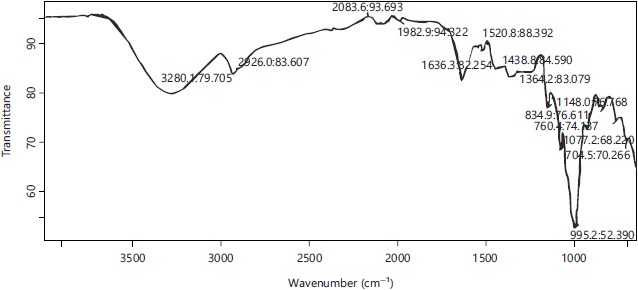
|

|
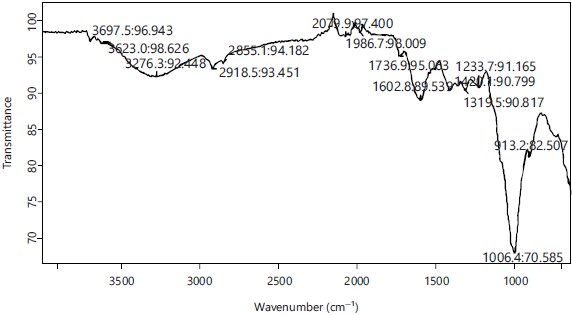
|
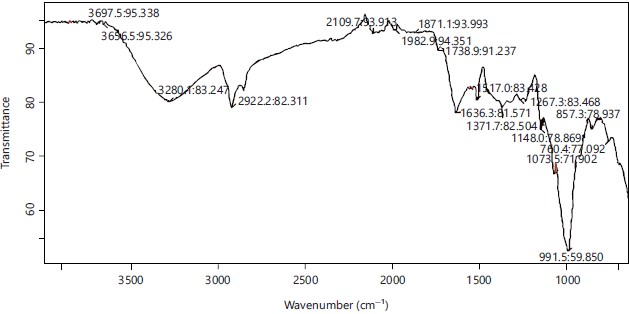
|
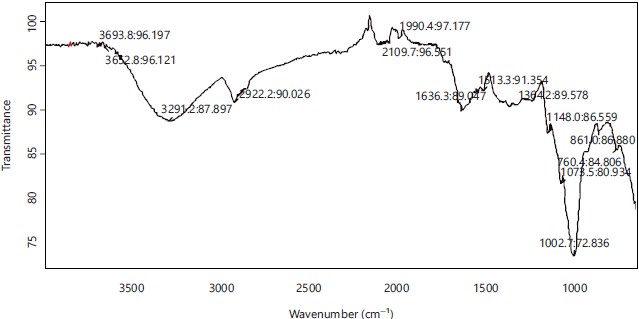
|
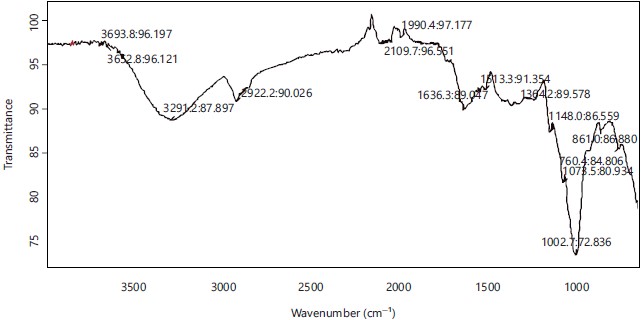
|
| Table 1: | Bioactive components from Garcinia kola FTIR spectrum | |||
| Wavelength number (cm–1) | Functional group | Inference |
| 3280 | O-H stretch, H-bonded | Alcohols, phenols |
| 2986 | C-H stretch | Alkanes and alkyls |
| 1982 | C=O stretch | Carbonyls (general) |
| 1636 | C=O stretch | Carboxylic acids |
| 1520 | C-C stretch (in-ring) | Aromatics |
| 1148 | C-N stretch | Aliphatic amines |
| 1077 | C-N stretch | Aliphatic amines |
| 995 | =C-H bend | Alkenes |
| Table 2: | Bioactive components from Vernonia amegdalina FTIR spectrum | |||
| Wavelength number (cm–1) | Functional group | Inference |
| 3749 | O-H stretch, free hydroxyl | Alcohols, phenols |
| 3280 | O-H stretch, H-bonded | Alcohols, phenols |
| 2922 | C-H stretch | Alkanes |
| 2322 | C≡N stretch | Nitriles |
| 2109 | C≡C stretch | Alkynes |
| 1640 | -C=C- stretch | Alkenes |
| 1375 | CH3C-H bend | Alkanes and alkyls |
| 1017 | C-F stretch | Alkyl halides |
| Table 3: | Bioactive components from Allium sativum FTIR spectrum | |||
| Wavelength number (cm–1) | Functional group | Inference |
| 3697 | O-H stretch, free hydroxyl | Alcohols, phenols |
| 3276 | N-H stretch 1°, 2° | Amines, amides |
| 2918 | O-H stretch | Carboxylic acids |
| 1986 | C-O stretch | Alcohols |
| 1602 | C-C stretch (in-ring) | Aromatics |
| 1319 | C-O stretch | Alcohols, carboxylic acids, esters, ethers |
| 1006 | C-F stretch | Alkyl halides |
| 913 | O-H bend | Carboxylic acids |
| Table 4: | Bioactive components from Zingiber officinale FTIR spectrum groups | |||
| Wavelength number (cm–1) | Functional group | Inference |
| 3697 | O-H stretch, free hydroxyl | Alcohols, phenols |
| 3280 | O-H stretch, H-bonded | Alcohols, phenols |
| 2922 | C-H stretch | Alkanes |
| 2109 | -C≡C- stretch | Alkynes |
| 1982 | C-O stretch | Alcohols |
| 1636 | N-H bend | 1° amines |
| 1517 | N-O asymmetric stretch | Nitro compounds |
| 1371 | C-H rock | Alkanes |
| 1148 | C-O stretch | Alcohols |
| 1073 | C-O stretch | Alcohols |
| 991 | =C-H bend | Alkenes |
| Table 5: | Bioactive components from Curcuma longa FTIR spectrum | |||
| Wavelength number (cm–1) | Functional group | Inference |
| 3268 | N-H stretch | 1°, 2° amines, amides |
| 2922 | O-H stretch | Carboxylic acids |
| 1990 | C=O stretch | Carbonyls (general) |
| 1632 | N-H bend | 1° amines |
| 1513 | N-O asymmetric stretch | Nitro compounds |
| 1334 | C-N stretch | Aromatic amines |
| 1148 | C-O-C stretch | Ethers |
| 1077 | C-O stretch | Alcohols |
| 998 | =C-H bend | Alkenes |
| 700 | -C≡C-H: C-H bend | Alkynes |
| Table 6: | Bioactive components from the FTIR spectrum of the mixture of the five plants | |||
| Wavelength number (cm–1) | Functional group | Inference |
| 3693 | O-H stretch, free hydroxyl | Alcohols, phenols |
| 3291 | N-H stretch | 1°, 2° amines, amides |
| 2922 | C-H stretch | Alkanes |
| 2109 | -C≡C- stretch | Alkynes |
| 1990 | C-O stretch | Alcohols |
| 1636 | N-H bend | 1° amines |
| 1513 | N-O asymmetric stretch | Nitro compounds |
| 1364 | C-H rock | Alkanes |
| 1148 | C-O-C stretch | Ethers |
| 1002 | C-N stretch | Aliphatic amines |
| 760 | C-Cl stretch | Alkyl halides |
DISCUSSION
Each functional group present in the methanol extract of the selected plant samples produced a characteristic absorption pattern at the functional group regions associated with wavenumber ranges from 3200-3600 cm–1 for O-H stretching in alcohols and carboxylic acids, 2900-3000 cm–1 for C-H stretching in alkanes and alkyl groups, 1700-1750 cm–1 for C=O stretching in carbonyl compounds such as aldehydes, ketones and carboxylic acids, 1600-1650 cm–1 for C=C stretching in conjugated alkenes and aromatic compounds,1400-1450 cm–1 for C-H bending in alkanes and alkyl groups, 1200-1300 cm–1 for C-N stretching in amines and amides and 1000-1100 cm–1 for C-O stretching in ethers, esters and carboxylic acids. The peak shapes exhibited by the functional groups at the functional group regions were usually broad whereas that at the fingerprint regions were narrow. On the other hand, the peak intensities were mild/weak at the functional groups regions while they showed more strong intensities especially at 1000 cm–1 wavenumber of the fingerprint regions.
Herbs are an essential source of phytochemicals that provide traditional medical therapy for a variety of ailments15. The primary source of functional components for the development of cutting-edge chemotherapeutic medicines is plants16. Infrared radiation is used in Fourier Transform Infrared (FTIR) spectroscopy, a vibrational spectroscopic technique, to cause molecular bonds in the material that absorbs it to vibrate. The majority of the samples have various subatomic bonds or unique arrangements of subatomic bonds. Data on the substances and particles inside the specimen were provided by the FTIR17. Based on the peak values in the area of IR radiation, the FTIR spectrum was used to identify the functional groups of the active components contained in the extracts. When the concentrate was introduced to the FTIR, the functional groups of the components were separated, providing a clear glimpse of the pinnacle proportion of the bioactive ingredients in the extracts.
The findings of this study are consistent with those of earlier investigations on different plants18-21, in which it was discovered that substances such as nitro compounds, 1°, 2° amines, amides, esters and aliphatic amines were present. Similar to this, Lanjwani et al.22 earlier screened the functional groups of carboxylic acids, amines, amides, sulphur derivatives, polysaccharides, organic hydrocarbons and halogens that are responsible for the various medicinal characteristics of Ricinus communis. Equally, in an ethylacetate leaf extract of Abutilon indicum, Saranya and Sekar23 employed FTIR to pinpoint functional group components of alcohols, phenols, alkanes, alkynes, alkyl halides, aldehydes, carboxylic acids and aromatics. Additionally, FTIR analysis of methanol leaf extracts of Senna auriculata, Phyllanthus maderaspatensis, Solanum torvum and Phyllanthus amarus confirmed the presence of amide, alcohols, phenols, alkanes, carboxylic acids, aldehydes, ketones and alkenes, primary amines, aromatics, esters, ethers, alkyl halides and aliphatic amines compounds, which showed major peaks24.
The plants gained therapeutic properties due to the presence of phenolic chemicals in them25. The fact that phenols and flavonoids have Hydroxyl groups (OH–) that are chemically linked directly to the benzene ring makes them the main antioxidants. This makes it simple for them to provide electrons to free radicals that are in need of them, lessening the threat they pose to the biological system26. Additionally, esters are a key factor in the synthesis of fragrance in plants since they are generally created by esterifying alcohol with fatty acids27. Amines have also been shown to be flavour precursors, therefore certain plants have the flavour that is linked with them28. The OH group was discovered to be present consistently in the methanol extracts of all the plants among the functional groups revealed in the extracts. The presence of the OH group, which has a propensity to generate hydrogen bonds, may imply that the methanol extract has a greater potential for inhibiting the growth of microbes29.
This study implied that the methanol extract of Vernonia amygdalina leaves, Allium sativum, Garcinia kola, Curcuma longa and Zingiber officinale investigated for their bioactive components showed the presence of promising functional groups of antioxidant molecules and hence the selected plants could be utilized for the formulation of viable agents against oxidative stress. On the contrary, the results of this research may have been affected by interferences of other substances in the samples or in the environment that absorb infrared radiation at the same wavenumber as the samples. Therefore, the selected plants should be purified for specific bioactive components to be fully utilized in herbal medicine.
CONCLUSION
The findings of the current study demonstrated the value of FTIR spectroscopy as a method for characterizing and analyzing the various biomolecules found in plant extracts. The study also comes to the conclusion that the five different plants included in the FTIR analysis show distinct differences among their biomolecules. The comparative analysis of the plants showed significant variance and it may be used to identify the plant that contained the highest concentration of phytoconstituents, which are plant-based treatments for a variety of ailments. The study’s findings show that these plants are crucial for medicine and that they may be further investigated for their efficacy and pharmacological effects in order to harness their potentials the pharmaceutical sector.
SIGNIFICANCE STATEMENT
This study discovered the presence of compounds with the functional groups of alkanes, alkenes, amines, carboxylic acids and alcohols in the extracts and their mixture that can be beneficial for polyherbal formulations for the treatment and management of different diseases. This study will help the researchers to uncover the critical areas of pharmacologic effect of their polyherbal mixture that many researchers were not able to explore. Thus a new theory on the mechanism of action may be arrived at.
REFERENCES
- Che, C.T., Z. Wang, M.S.S Chow and C.W.K. Lam, 2013. Herb-Herb combination for therapeutic enhancement and advancement: Theory, practice and future perspectives. Molecules, 18: 5125-5141.
- Risberg, K., O. Fodstad and Y. Andersson, 2011. Synergistic anticancer effects of the 9.2.27PE immunotoxin and ABT-737 in melanoma. PLoS ONE, 6: e24012.
- Ramaiah, M., G. Chakravathi and K. Yasaswini, 2013. In vitro biological standardization, formulation and evaluation of directly compressed polyherbal anthelmintic tablets. Pharmacogn. J., 5: 130-134.
- Aslam, M.S., M.S. Ahmad, A.S. Mamat, M.Z. Ahmad and F. Salam, 2016. An update review on polyherbal formulation: A global perspective. Syst. Rev. Pharm., 7: 35-41.
- George, S.K., R. Rajesh, S.S. Kumar, B. Sulekha and P. Balaram, 2008. A polyherbal ayurvedic drug-Indukantha Ghritha as an adjuvant to cancer chemotherapy via immunomodulation. Immunobiology, 213: 641-649.
- Ajazuddin and S. Saraf, 2010. Evaluation of physicochemical and phytochemical properties of Safoof-E-Sana, a Unani polyherbal formulation. Pharmacogn. Res., 2: 318-322.
- Petchi, R.R., S. Parasuraman, C. Vijaya, S.V.G. Krishna and M.K. Kumar, 2015. Antiarthritic activity of a polyherbal formulation against Freund's complete adjuvant induced arthritis in female Wistar rats. J. Basic Clin. Pharm., 6: 77-83.
- Jain, D.P., S.S. Pancholi and R. Patel, 2011. Synergistic antioxidant activity of green tea with some herbs. J. Adv. Pharm. Technol. Res., 2: 177-183.
- Gauttam, V.K. and A.N. Kalia, 2013. Development of polyherbal antidiabetic formulation encapsulated in the phospholipids vesicle system. J. Adv. Pharm. Tech. Res., 4: 108-117.
- Sheehan, P., P. Jones, A. Caselli, J.M. Giurini and A. Veves, 2003. Percent change in wound area of diabetic foot ulcers over a 4-week period is a robust predictor of complete healing in a 12-week prospective trial. Diabetes, 26: 1879-1882.
- Mandlik, R.V., Desai, S.K. Naik, S.R. Sharma, G. Kohli and R.K. Kohli, 2008. Antidiabetic activity of a polyherbal formulation (DRF/AY/5001). Indian J. Exp. Biol., 46: 599-606.
- Tripathi, Y.B., B.K. Singh, R.S. Pandey and M. Kumar, 2005. BHUx: A patent polyherbal formulation to prevent atherosclerosis. Evidence Based Complementary Altern. Med., 2: 217-221.
- Kajaria, D.K., M. Gangwar, A.K. Sharma, Y.B. Tripathi, J.S. Tripathi and S. Tiwari, 2012. Evaluation of in vitro antioxidant capacity and reducing potential of polyherbal drug-Bhāraṅgyādi. Ancient Sci. Life, 32: 24-28.
- Pakkirisamy, M., S.K. Kalakandan and K. Ravichandran, 2017. Phytochemical screening, GC-MS, FT-IR analysis of methanolic extract of Curcuma caesia roxb (black turmeric). Pharm. J., 9: 952-956.
- Tanaka, N. and Y. Kashiwada, 2021. Phytochemical studies on traditional herbal medicines based on the ethnopharmacological information obtained by field studies. J. Nat. Med., 75: 762-783.
- Desai, A.G., G.N. Qazi, R.K. Ganju, M. El-Tamer and J. Singh et al., 2008. Medicinal plants and cancer chemoprevention. Curr. Drug Metab., 9: 581-591.
- Baker, M.J., E. Gazi, M.D. Brown, J.H. Shanks, P. Gardner and N.W. Clarke, 2008. FTIR-based spectroscopic analysis in the identification of clinically aggressive prostate cancer. Br. J. Cancer, 99: 1859-1866.
- Kumar, S.S., P. Manoj and P. Giridhar, 2015. Fourier transform infrared spectroscopy (FTIR) analysis, chlorophyll content and antioxidant properties of native and defatted foliage of green leafy vegetables. J. Food Sci. Technol., 52: 8131-8139.
- Devi, D.R. and G.R. Battu, 2019. Qualitative phytochemical screening and FTIR spectroscopic analysis of Grewia tilifolia (Vahl) leaf extracts. Int. J. Curr. Pharm. Res., 11: 100-107.
- Zavoi, S., F. Fetea, F. Ranga, R.M. Pop, A. Baciu and C. Socaciu, 2011. Comparative fingerprint and extraction yield of medicinal herb phenolics with hepatoprotective potential, as determined by UV-Vis and FT-MIR spectroscopy. Notulae Botanicae Horti Agrobotanici Cluj Napoca, 39: 82-89.
- Brangule, A., R. Sukele and D. Bandere, 2020. Herbal medicine characterization perspectives using advanced FTIR sample techniques-diffuse reflectance (DRIFT) and photoacoustic spectroscopy (PAS). Front. Plant Sci., 11: 356.
- Lanjwani, A.H., A.A. Memon, S. Bhitti, I.H. Ghanghro, A.B. Ghanghro and Q. Shah, 2020. FTIR spectral analysis, phytochemical and biological activity of ricinus communis. Int. J. Adv. Res., 8: 1174-1183.
- Saranya, D. and J. Sekar, 2016. GC-MS and FT-IR analyses of ethylacetate leaf extract of Abutilon indicum (L.) Sweet. Int. J. Adv. Res. Biol. Sci., 3: 193-197.
- Ashokkumar, R. and M. Ramaswamy, 2014. Phytochemical screening by FTIR spectroscopic analysis of leaf extracts of selected Indian medicinal plants. Int. J. Curr. Microbiol. Appl. Sci., 3: 395-406.
- Gil, M.I., F.A. Tomas-Barberan, B. Hess-Pierce and A.A. Kader, 2002. Antioxidant capacities, phenolic compounds, carotenoids, and vitamin C contents of nectarine, peach, and plum cultivars from California. J. Agric. Food Chem., 50: 4976-4982.
- Uyoh, E.A., P.N. Chukwura, I.A. David and A.C. Bassey, 2013. Evaluation of antioxidant capacity of two Ocimum species consumed locally as spices in Nigeria as a justification for increased domestication. Am. J. Plant Sci., 4: 221-229.
- van der Sluis, A.A., M. Dekker, G. Skrede and W.M.F. Jongen, 2002. Activity and concentration of polyphenolic antioxidants in apple juice. 1. Effect of existing production methods. J. Agric. Food Chem., 50: 7211-7219.
- Schwab, W., R. Davidovich-Rikanati and E. Lewinsohn, 2008. Biosynthesis of plant-derived flavor compounds. Plant J., 54: 712-732.
- Patra, A.K., 2012. An Overview of Antimicrobial Properties of Different Classes of Phytochemicals. In: Dietary Phytochemicals and Microbes, Patra, A.K. (Ed.), Springer, Dordrecht, Netherlands, ISBN: 978-94-007-3925-3, pp: 1-32.
How to Cite this paper?
APA-7 Style
Abu,
M.S., Tatah,
S.V., Okpe,
O., Abah,
M., Abe,
R.H. (2023). Identification of Bioactive Compounds in Methanolic Extracts of Some Selected Plants by Infrared Spectroscopy. Research Journal of Phytochemistry, 17(1), 1-10. https://doi.org/10.3923/rjphyto.2023.01.10
ACS Style
Abu,
M.S.; Tatah,
S.V.; Okpe,
O.; Abah,
M.; Abe,
R.H. Identification of Bioactive Compounds in Methanolic Extracts of Some Selected Plants by Infrared Spectroscopy. Res. J. Phytochem 2023, 17, 1-10. https://doi.org/10.3923/rjphyto.2023.01.10
AMA Style
Abu
MS, Tatah
SV, Okpe
O, Abah
M, Abe
RH. Identification of Bioactive Compounds in Methanolic Extracts of Some Selected Plants by Infrared Spectroscopy. Research Journal of Phytochemistry. 2023; 17(1): 1-10. https://doi.org/10.3923/rjphyto.2023.01.10
Chicago/Turabian Style
Abu, Michael, Sunday, Silas Verwiyeh Tatah, Oche Okpe, Moses Abah, and Rabiu Hanifa Abe.
2023. "Identification of Bioactive Compounds in Methanolic Extracts of Some Selected Plants by Infrared Spectroscopy" Research Journal of Phytochemistry 17, no. 1: 1-10. https://doi.org/10.3923/rjphyto.2023.01.10

This work is licensed under a Creative Commons Attribution 4.0 International License.




